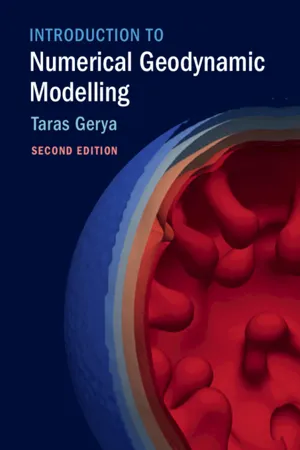
- English
- PDF
- Available on iOS & Android
Introduction to Numerical Geodynamic Modelling
About this book
This hands-on introduction to numerical geodynamic modelling provides a solid grounding in the necessary mathematical theory and techniques, including continuum mechanics and partial differential equations, before introducing key numerical modelling methods and applications. Fully updated, this second edition includes four completely new chapters covering the most recent advances in modelling inertial processes, seismic cycles and fluid-solid interactions, and the development of adaptive mesh refinement algorithms. Many well-documented, state-of-the-art visco-elasto-plastic 2D models are presented, which allow robust modelling of key geodynamic processes. Requiring only minimal prerequisite mathematical training, and featuring over sixty practical exercises and ninety MATLAB® examples, this user-friendly resource encourages experimentation with geodynamic models. It is an ideal introduction for advanced courses and can be used as a self-study aid for graduates seeking to master geodynamic modelling for their own research projects.
Frequently asked questions
- Essential is ideal for learners and professionals who enjoy exploring a wide range of subjects. Access the Essential Library with 800,000+ trusted titles and best-sellers across business, personal growth, and the humanities. Includes unlimited reading time and Standard Read Aloud voice.
- Complete: Perfect for advanced learners and researchers needing full, unrestricted access. Unlock 1.4M+ books across hundreds of subjects, including academic and specialized titles. The Complete Plan also includes advanced features like Premium Read Aloud and Research Assistant.
Please note we cannot support devices running on iOS 13 and Android 7 or earlier. Learn more about using the app.
Information
Table of contents
- Cover
- Half-title page
- Reviews
- Title page
- Copyright page
- Contents
- Preface to the second edition
- Acknowledgements
- Introduction
- 1 The continuity equation
- 2 Density and gravity
- 3 Numerical solutions of partial differential equations
- 4 Stress and strain
- 5 The momentum equation
- 6 Viscous rheology of rocks
- 7 Numerical solutions of the momentum and continuity equations
- 8 The advection equation and marker-in-cell method
- 9 The heat conservation equation
- 10 Numerical solution of the heat conservation equation
- 11 2D thermomechanical code structure
- 12 Elasticity and plasticity
- 13 2D implementation of visco-elasto-plasticity
- 14 2D thermomechanical modelling of inertial processes
- 15 Seismo-thermomechanical modelling
- 16 Hydro-thermomechanical modelling
- 17 Adaptive mesh refinement
- 18 The multigrid method
- 19 Programming of 3D problems
- 20 Numerical benchmarks
- 21 Design of 2D numerical geodynamic models
- Outlook
- Appendix MATLAB program examples
- References
- Index